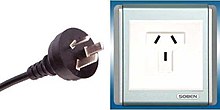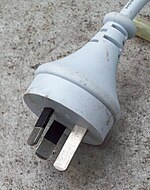Connector type I.
The connector type I ( Australian 2/3-pin ) is used in Australia, New Zealand, Papua New Guinea, China, Argentina, Uruguay and Tajikistan.
General
This connector, which is used in Australia, New Zealand, Papua New Guinea, China, Argentina, Uruguay and Tajikistan, is three-pole, has a protective contact and is designed for a rated current of 10 A. The protective contact is a vertical flat contact. Neutral and phase are in the shape of an upside down V above. They are each rotated by 30 ° against the protective contact and have a nominal distance of 13.7 mm. Such sockets usually have a voltage of 230 V at 50 Hz. Since 2005, finger-safe insulation of the current-carrying contacts has been mandatory.
distribution
The following countries use connector systems classified as type I:
- Australia : relevant standard: AS / NZS 3112
- New Zealand : relevant standard: AS / NZS 3112
- Papua New Guinea : relevant standard: AS / NZS 3112
- China (partially): relevant standard: GB 1002
- Argentina : relevant standard: IRAM 2073
- Uruguay : relevant standard: standard IRAM 2073
Norms
There are several standards for the Type I connector, each defining very similar connector systems. The most authoritative and oldest is the Australian standard AS 3112.
AS 3112 (Australia)
Originally defined as the C112 standard in Australia in 1937/1938 , the standard was replaced by the AS 3112 standard in 1990 . Standard in Australia , New Zealand and Papua New Guinea since the beginning , AS 3112 is now the relevant standard for these countries. The standard defines a polarized plug in which the phase (active) is on the left in relation to the socket. Right is neutral and earth in the lower middle. The contacts are flat metal pins with rounded ends with the dimensions 6.5 mm × 1.6 mm. The current-carrying contacts are 18 mm long and twisted at an A-shaped angle of 30 ° with respect to the protective conductor and have a nominal distance of 13.7 mm. The protective conductor is 20 mm longer and thus somewhat ahead in haste . When plugging in, the earth contact is made before the power supply and when unplugging it is the last to be disconnected. Since 2003, the standard has also included finger safety , which is achieved by insulating the two current-carrying conductors with a width of 9 mm . The last and authoritative standard from 2003 is AS / NZS 3112: 2000 . It prescribes the isolated contacts from 2005.
IRAM 2073 (Argentina)
A similar connector exists in Argentina and Uruguay. The most important difference is that the neutral conductor and phase are reversed.
GB 1002 (China)
In the People's Republic of China, there is a standard that is very similar to the Australian standard, but not mechanically identical. The most important difference is that the sockets are rotated 180 °. The (basically existing) protective contact is therefore on top and not on the bottom. There is no insulation of the conductors. There is also a 16A version, mostly intended for the installation of air conditioning systems and mounted at head height, in which all contacts are thicker, longer and higher. The specified nominal voltage in the PRC is 220 V +7% / - 10%.
At the same time, the connector type A or NEMA-1 (for applications without a protective conductor up to 10 A) is defined in GB 1002 . Modern sockets also accept the Euro plug type C according to CEE 7/16.
variants
In addition to the 10 A version, there is also a variant that is approved for a rated current of 15 A. It has a slightly thicker, longer and higher protective contact. These sockets are backwards compatible with the 10 A plugs. There is also a 20 A version in which all contacts are thicker, longer and higher, a 25 and 32 A version in which the contact pins are enlarged just like the 20 A version. In the 25 A variant, the protective conductor is in the form of a mirrored L, in the 32 A variant it is in the form of a square U. All sockets are downward compatible. So they each take on plugs with a lower rated current, but not the other way around.
A two-pole variant of the 10 A plug is available for double-insulated Class II devices. It fits into all socket variants, but offers a poorer grip due to the lack of a protective contact. It can usually be found where the Euro plug would be used in Europe .
additional
The Australian standard AS 3112 also specifies multiple plugs in various designs and plugs for self-assembly.


